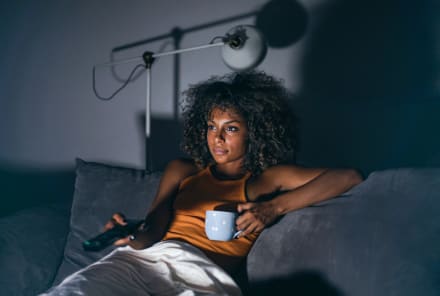Advertisement
I Had Post-Birth-Control Syndrome. Here Are The Foods & Lifestyle Habits That Helped Me

As a registered dietitian, I routinely work with women of all ages to help them balance their hormones, fight fatigue, move through sticky and slow weight loss, promote sleep—basically anything and everything hormone-related. I’m fairly versed in what to do and how to help my clients. But this time it was about me.
What happened when I stopped taking the pill
Rewind to about a year and a half ago, I was 28 and had been on birth control for six years (the Nuvaring). At the time, many friends and colleagues were telling me of their newly diagnosed polycystic ovary syndrome, newly found fertility struggles, and hormonal issues—and they’d only pinpointed it once they had stopped taking or using birth control. This startled me. I, too, began to worry about my own fertility and period health as I had been put on birth control for "hormone balance" six years prior.
I decided it was time for me to discontinue the ring and see what happened.
After two months of being off the Nuvaring I felt normal—better than normal, even. I appreciated the monthly highs and lows of energy that most women experienced, and for the first time in a long time, I felt like I was in better tune with my body. A few weeks later at my annual gynecology visit, I discussed with my doctor my decision, and she was supportive, which was also welcome. Everything continued to feel good, and I felt that I had made the right decision.
And then…
Two months later, everything changed. My mood was ever turbulent, I cried sometimes without warning, my skin was broken out in every direction, my period was no longer regular, my boobs were swollen and painful for two to three weeks before my period, my sleep was irregular, I was absolutely EXHAUSTED, and frankly, I was miserable. I was so confused because I didn't know what had gone wrong or what had changed.
My "a-ha moment"
After doing some research, I learned that what I was experiencing can be a fairly common issue and is often labeled post-birth-control syndrome. From my research I learned that post-birth-control syndrome (PCBS) generally occurs between four and six months after stopping birth control and can include symptoms like hormonal changes, breast tenderness, acne, mood disorders and depression, stomach upset, and more. PCBS happens due to imbalances after our bodies start to produce hormones independently of the pill. It doesn’t happen to everyone, but it’s a major problem.
I had a very clear "a-ha moment" and felt somewhat relieved that this terrible feeling had a name…but now what? I reached out to my integrative medicine doctor who tested my blood, and sure enough my progesterone was really low (which can be a common issue both with PCBS and post birth control). So I started taking various supplements, giving in to my exhaustion, focused on eating for hormone balance, and was determined to find a way out. And so I did.
A year and a half later I’m finally feeling like myself, and though I’m sure with more information I could have helped myself sooner, what I learned throughout the process is and was invaluable to my health and my mental wellness. At this point I have used what I learned through my research, my own doctor visits, discussing with other practitioners and more, to help women suffering from hormonal imbalance and PCBS.
The eight strategies that helped me
1. I focused on promoting healthy progesterone.
It’s quite common for progesterone to be on the lower side after stopping birth control, and this is what can cause or contribute to many of the ugly symptoms. Here are a few things that I did to get back towards normal:
- Exercise but don't overdo it. Heavy exercise too often can actually raise cortisol levels that can decrease progesterone levels.
- Eat foods rich in vitamin C like limes, lemons, strawberries, oranges, spinach, Brussels sprouts.
- Eat magnesium-rich foods, like green leafy vegetables, nuts and seeds, and black beans.
- Eat a lot of B6, from sources like salmon, ncuts and seeds, eggs, beans, and legumes.
- Consume L-arginine-rich food, like turkey, chicken, pumpkin seeds, spirulina, edamame, and lentils.
- Fill up on fibrous foods like nuts and seeds, raw and cooked vegetables, beans, and legumes.
2. I practiced hormone-healthy eating habits.
Our hormones respond to the food we eat in a big way, especially when they’re really unbalanced.
- Cut back on added sugar wherever you can. Sugar can exhaust the adrenal system and can get in the way of healthy mood and happiness. Fruit sugar is OK, but stick to two to three servings daily at most.
- Try to include more carbs earlier in the day, and fewer at night.
- Cut back (and cut out if you can) caffeine. Consuming too much caffeine can increase cortisol, which isn’t helpful for hormonal balance.
- Try to eat more fiber. Regular bowel movements are key for hormonal balance, and fiber can help to promote this. Most people should aim for 30 g of fiber or more per day (eat this in 1 day to reach 30 g: 20 almonds + ½ cup lentils + 1 cup raspberries + 1 cup broccoli + 1 cup broccoli).
3. I considered, and used, certain herbs and supplements.
I want to caution you about doses because everyone is different, but if you are working with an alternative medicine doctor or dietitian/nutritionist, these are some of the ones I tried.
- Vitamin C with bioflavonoids
- Calcium
- Chasteberry
- Ashwagandha
- Probiotics
- Dong quai
4. I got more sleep.
Sleep is KEY for hormonal balance. Like me, you may have trouble getting sleep, so try to set up a happy nightly routine, like taking a bath, doing some gentle yoga, coloring, reading, or doing something quiet that feels good for your body and your mind. This is really helpful.
5. Learn how to cycle sync.
It can sound overwhelming and confusing, but honestly it’s so helpful, and though your cycle may not be regular, keeping an eye on when you get your period and learning the rough dates of your cycle can help you to understand your energy, cravings, moods in business and socially, and so much more.
6. I worked on being more kind to myself.
Things may more easily frustrate you, get in the way of what you’re used to be able to accomplish, but be patient. Try something new like meditation or yoga—both can help to soothe your mind and help to balance cortisol levels, which is key for contributing to balanced hormones in general. Though it can feel overwhelming to start a new practice like this, it’s so helpful and can really help to quiet the mind during an otherwise tumultuous time.
7. I looked for help where I needed it.
Therapists, dietitians, your doctors—we’re all here to help you, so if you want or need help (which most of us do!) reach out. The best thing I did was to reach out to my community and ask for help, something I’ve often shied away from in the past.
8. Be open to new ways of healing.
I can’t say this enough: There’s no one magic pill; it all works in concert. Trying new modalities of treatment like cupping (a massage technique), functional manual therapy (a type of mobility-promoting physical therapy), acupuncture, Reiki—honestly, it all helps our bodies to work better and feel better. Give any of them a try—you never know what's going to work for your body.
Watch Next
Enjoy some of our favorite clips from classes
Enjoy some of our favorite clips from classes
What Is Meditation?
Mindfulness/Spirituality | Light Watkins
Box Breathing
Mindfulness/Spirituality | Gwen Dittmar
What Breathwork Can Address
Mindfulness/Spirituality | Gwen Dittmar
The 8 Limbs of Yoga - What is Asana?
Yoga | Caley Alyssa
Two Standing Postures to Open Up Tight Hips
Yoga | Caley Alyssa
How Plants Can Optimize Athletic Performance
Nutrition | Rich Roll
What to Eat Before a Workout
Nutrition | Rich Roll
How Ayurveda Helps Us Navigate Modern Life
Nutrition | Sahara Rose
Messages About Love & Relationships
Love & Relationships | Esther Perel
Love Languages
Love & Relationships | Esther Perel
What Is Meditation?
Box Breathing
What Breathwork Can Address
The 8 Limbs of Yoga - What is Asana?
Two Standing Postures to Open Up Tight Hips
How Plants Can Optimize Athletic Performance
What to Eat Before a Workout
How Ayurveda Helps Us Navigate Modern Life
Messages About Love & Relationships
Love Languages
Advertisement

These Peanut Butter Cup Protein Bites Make The Perfect On-The-Go Snack
Molly Knudsen, M.S., RDN










